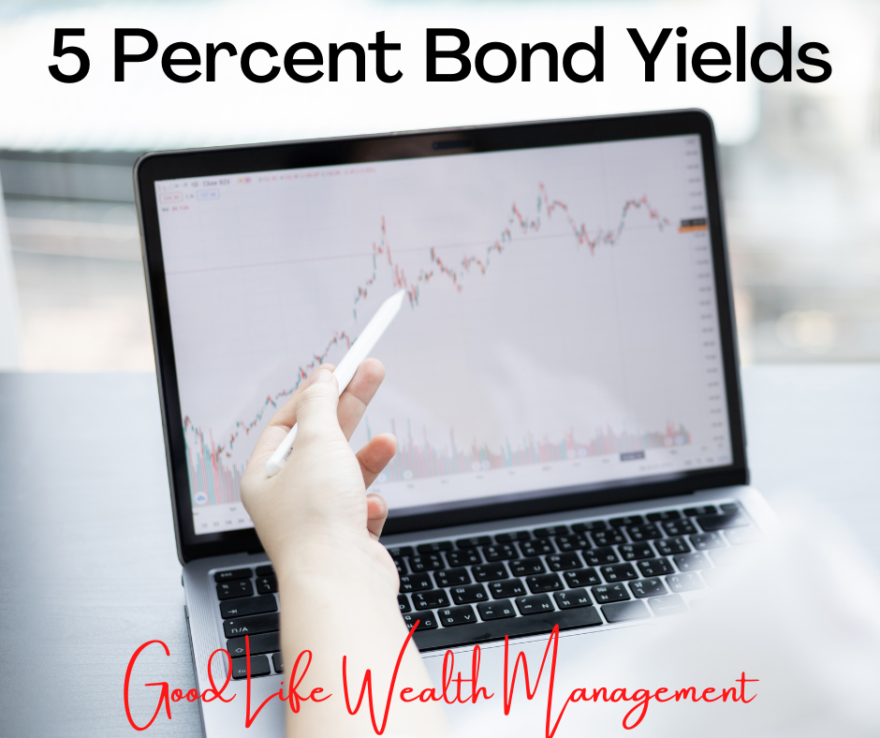They’re back – 5 percent bond yields are here. For the first time in over a decade, I bought a high quality bond with a 5 percent yield this week. It was a Freddie Mac bond maturing in five years, with a 5% coupon and selling for a few pennies under par. That’s a AAA government agency bond at 5%.
Since the Great Recession of 2008, we’ve lived with very low interest rates, which has penalized savers and conservative investors. When I started as an advisor, some 18 and a half years ago, 5% yields were readily available. We could make a balanced portfolio with half in 5% bonds and half in dividend stocks. The stocks offered a dividend yield of 3% or more. And that portfolio would provide a 4% withdrawal rate for retirees – without touching their principal.
I am happy to see 5 percent bond yields return and to me it is a remarkable threshold. We have many clients who will be quite happy with these bonds in their portfolio. And at 5%, the return from bonds is high enough that the risk/reward of stocks will become less appealing. To many, a sure 5% return is more attractive than a potential 7-8% stock return that can go down 20% over a couple of months.
It’s Complicated
So, should you sell all your existing bonds (or stocks) and buy some 5% bond yields? Well, it’s a little more complicated than that. Here are some things to keep in mind.
First, you probably already own 5% bond yields, if you have any bonds. As interest rates rise, bond prices fall. Here is an example of how two one-year bonds could have 5% yields:
- 5% coupon and price is 100 = 5% yield to maturity
- 2% coupon and price is 97 = 5% yield to maturity
The reality is that 5% yields are available today because the price of bonds has gotten crushed in 2022. If you have individual bonds or bond funds, it’s likely some of those bonds are already priced to 5% yields. You might not need to do anything to achieve 5% returns over the remaining life of those bonds.
Second, the Fed is not done raising interest rates. As interest rates increase, bond prices will go down. Even though we are buying 5% yields today, it is possible that these bonds will be worth less than we paid six months from now. And when you look at the cover page on your statement, you will be disappointed that your portfolio is still “losing money”. More about this later.
Third, selling stocks when they are down 20% has been a poor choice historically. Yes, the stock market is not out of the woods yet and it is likely there is more pain to come. Still, it is possible that stocks could recover their 20% losses faster than switching to bonds now. Even at 5%, you’d need 5 years to make back the 20% loss in stocks. Market timing is usually a worse choice than sticking to a long-term plan. Be cautious about making big changes.
Lastly, inflation is still 8-9 percent. Even though I am excited about 5 percent bond yields, it remains a negative real return. You are still not keeping up with today’s inflation. It’s better than making 0% in your checking account, but let’s not forget that you aren’t actually growing your purchasing power.
Three Things We Are Doing
We started the year having moved to short-term bonds in expectation of rising interest rates. This worked well and greatly reduced losses. Now that higher rates are here, we are taking a three-part approach.
- Individual bonds over funds. Where practical, we prefer to own individual bonds over funds. Then we can hold the bonds to maturity and receive back our principal. It is simple. With funds, there are a lot of moving parts and many funds are constantly buying and selling bonds. If the price of our bond drops to 97, at least we know we plan to hold it and eventually receive 100.
- Laddered 1-5 years. We build laddered bond portfolios from 1-5 years, so each year we have bonds maturing. Clients can take cash or reinvest. In some cases, we are buying 6 month bonds and waiting to buy longer bonds later.
- We are adding to core bonds and reducing other categories of bonds and alternatives, given the yields available today. Cash and dividends are getting reinvested into bonds now.
Although inflation is high right now, it will likely be coming down in 2023. The Federal Reserve is raising rates and is planning to put the economy into recession and increase unemployment. The magnitude of the reversal from the Pandemic stimulus of 2020 is unlike anything the world has ever seen. The economy and the stock market may be in for a wild ride. And in this environment, I think 5 percent bond yields have never looked better.




